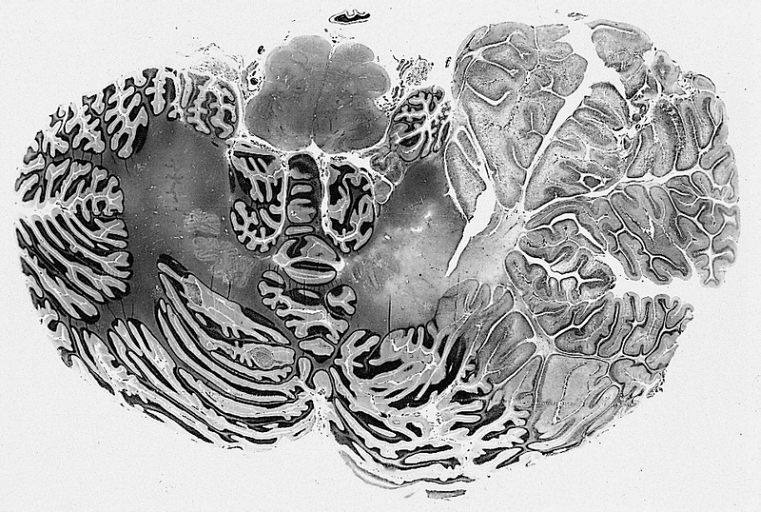Cowden Syndrome

Cowden syndrome is a disorder characterized by multiple noncancerous, tumor-like growths called hamartomas and an increased risk of developing certain cancers.
Almost everyone with Cowden syndrome develops hamartomas. These growths are most commonly found on the skin and mucous membranes (such as the lining of the mouth and nose), but they can also occur in the intestine and other parts of the body. The growth of hamartomas on the skin and mucous membranes typically becomes apparent by a person's late twenties.
Cowden syndrome is associated with an increased risk of developing several types of cancer, particularly cancers of the breast, a gland in the lower neck called the thyroid, and the lining of the uterus (the endometrium). Other cancers that have been identified in people with Cowden syndrome include colorectal cancer, kidney cancer, and a form of skin cancer called melanoma. Compared with the general population, people with Cowden syndrome develop these cancers at younger ages, often beginning in their thirties or forties. Other diseases of the breast, thyroid, and endometrium are also common in Cowden syndrome. Additional signs and symptoms can include an enlarged head (macrocephaly) and a rare, noncancerous brain tumor called Lhermitte-Duclos disease. A small percentage of affected individuals have delayed development or intellectual disability.
The features of Cowden syndrome overlap with those of another disorder called Bannayan-Riley-Ruvalcaba syndrome. People with Bannayan-Riley-Ruvalcaba syndrome also develop hamartomas and other noncancerous tumors. Both conditions can be caused by mutations in the PTEN gene. Some people with Cowden syndrome have had relatives diagnosed with Bannayan-Riley-Ruvalcaba syndrome, and other individuals have had the characteristic features of both conditions. Based on these similarities, researchers have proposed that Cowden syndrome and Bannayan-Riley-Ruvalcaba syndrome represent a spectrum of overlapping features known as PTEN hamartoma tumor syndrome instead of two distinct conditions.
Some people have some of the characteristic features of Cowden syndrome, particularly the cancers associated with this condition, but do not meet the strict criteria for a diagnosis of Cowden syndrome. These individuals are often described as having Cowden-like syndrome.
Frequency
Although the exact prevalence of Cowden syndrome is unknown, researchers estimate that it affects about 1 in 200,000 people.
Causes
Changes involving at least four genes, PTEN, SDHB, SDHD, and KLLN, have been identified in people with Cowden syndrome or Cowden-like syndrome.
Most cases of Cowden syndrome and a small percentage of cases of Cowden-like syndrome result from mutations in the PTEN gene. The protein produced from the PTEN gene is a tumor suppressor, which means that it normally prevents cells from growing and dividing (proliferating) too rapidly or in an uncontrolled way. Mutations in the PTEN gene prevent the protein from regulating cell proliferation effectively, leading to uncontrolled cell division and the formation of hamartomas and cancerous tumors. The PTEN gene likely has other important functions within cells; however, it is unclear how mutations in this gene cause the other features of Cowden syndrome, such as macrocephaly and intellectual disability.
Other cases of Cowden syndrome and Cowden-like syndrome result from changes involving the KLLN gene. This gene provides instructions for making a protein called killin. Like the protein produced from the PTEN gene, killin probably acts as a tumor suppressor. The genetic change that causes Cowden syndrome and Cowden-like syndrome is known as promoter hypermethylation. The promoter is a region of DNA near the gene that controls gene activity (expression). Hypermethylation occurs when too many small molecules called methyl groups are attached to the promoter region. The extra methyl groups reduce the expression of the KLLN gene, which means that less killin is produced. A reduced amount of killin may allow abnormal cells to survive and proliferate inappropriately, which can lead to the formation of tumors.
A small percentage of people with Cowden syndrome or Cowden-like syndrome have variations in the SDHB or SDHD gene. These genes provide instructions for making parts of an enzyme called succinate dehydrogenase (SDH), which is important for energy production in the cell. This enzyme also plays a role in signaling pathways that regulate cell survival and proliferation. Variations in the SDHB or SDHD gene alter the function of the SDH enzyme. Studies suggest that the defective enzyme may allow cells to grow and divide unchecked, leading to the formation of hamartomas and cancerous tumors. However, researchers are uncertain whether the identified SDHB and SDHD gene variants are directly associated with Cowden syndrome and Cowden-like syndrome. Some of the variants described above have also been identified in people without the features of these conditions.
When Cowden syndrome and Cowden-like syndrome are not related to changes in the PTEN, SDHB, SDHD, or KLLN genes, the cause of the conditions is unknown.
Learn more about the genes associated with Cowden syndrome
Inheritance Pattern
Cowden syndrome and Cowden-like syndrome are inherited in an autosomal dominant pattern, which means one copy of the altered gene in each cell is sufficient to cause the condition and increase the risk of developing cancer. In some cases, an affected person inherits the mutation from one affected parent. Other cases may result from new mutations in the gene. These cases occur in people with no history of the disorder in their family.